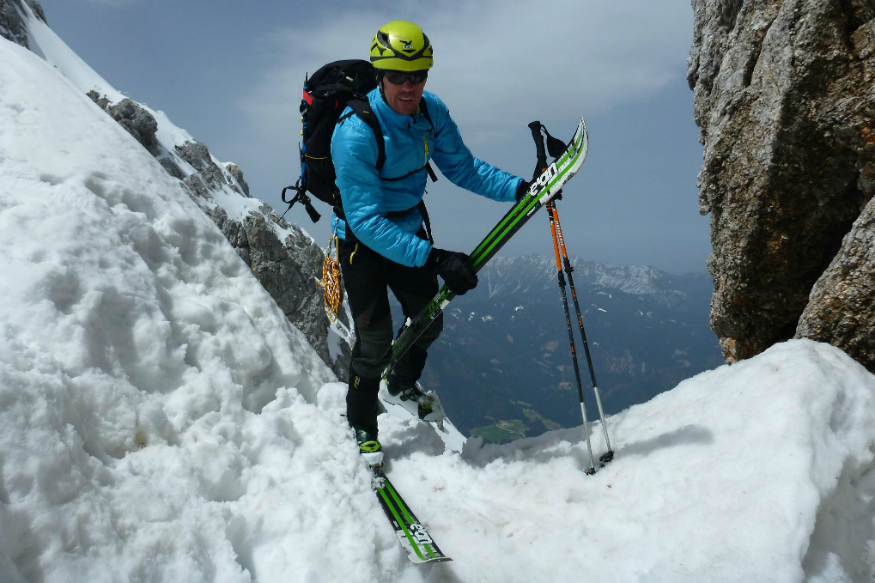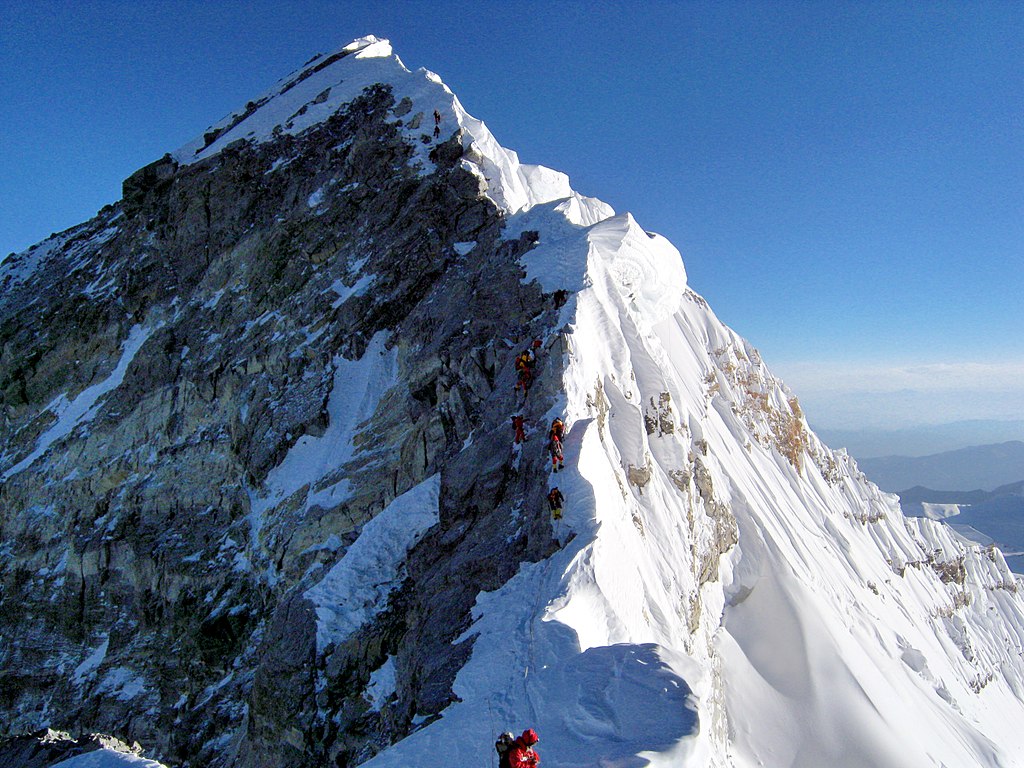Davo Karnicar was a soft-spoken hero. Best known for skiing nonstop from the summit of Everest in 2000, along the knife-edged summit ridge, over the Hillary Step, down the precipitous Lhotse Face, and through the Khumbu Icefall, he descended 12,000 vertical feet in four hours and forty minutes, without ever removing his skis.
The exploit was streamed live online, with four million people watching around the world. Karnicar would rather have done without the cameras and hype, but the permit alone cost $70,000. How else was a ski tuner and father of four from Slovenia supposed to pay for a groundbreaking expedition to the top of the world?
“Skiing on ridges is like being on a knife’s edge. Many times, part of my skis were hanging over into Tibet, and sometimes into Nepal”
“I tried to raise the money for two years but failed,” he said in a 2002 interview with Planet Mountain’s Emilio Previtali. Then a friend came up with the idea of transmitting the entire expedition live on the internet. Sponsors lined up, and Karnicar had his permit and his team, who climbed with him and placed cameras at strategic locations along the route.
“If I’ve stood on the summit of Everest with my skis, then it’s only thanks to the internet,” Karnicar said.
The live feed is now buried beyond the reach of Google and even the Wayback Machine, which saved the website but not the video. The first complete ski descent of Everest, like Karnicar himself, became a kind of underground legend.
“His motivations are in the right place,” American ski mountaineer Dave Watson said in 2017, when Karnicar made his second attempt to ski from the summit of K2, using folding skis of his own design. “He’s doing it for the beauty of the mountain and his desire to go and have fun.”
Karnicar continued to notch noteworthy ski descents, becoming the second person to ski from the Seven Summits in 2006, finishing just weeks after American Kit DesLauriers completed the same project. He could have contested her claim— DesLauriers took two days to descend Everest, arguably making her line incomplete—but he didn’t bother. The summits had been a personal quest and a way to support his family while continuing to ski and climb. His family had expanded to seven children and two grandchildren, and since 1980 he’d made an estimated 1,700 climbs and descents in the Alps and around the world. What more could he want?
BORN TO THE MOUNTAINS
Davorin “Davo” Karnicar was born in 1962 in Slovenia, then a mountain enclave of Yugoslavia. His father was a mountain guide and long-time caretaker of the Češka hut, a rugged lodge perched on a limestone cirque near the Austrian border. Karnicar spent every spare moment exploring the mountains with his sister and three brothers, all of whom became formidable skiers and alpinists.
He earned a spot on the Yugoslavian ski team and spent many years on the World Cup circuit, though most of that time he worked as a technician, far from the limelight. He skied the Northeast Face of the Eiger and the East Face of the Matterhorn. He climbed and skied the hardest lines in Slovenia and found an unlikely route down a frozen waterfall near his childhood home, skiing it seven times over the years. And every so often he accumulated enough money and time for a high-mountain expedition.
 Karnicar at home in the Slovenian Alps. Photo courtesy Karnicar archive
Karnicar at home in the Slovenian Alps. Photo courtesy Karnicar archive
In 1989 he climbed Nanga Parbat, the ninth-highest mountain in the world. In 1993 he went to K2 for the first time, intent on skiing from the world’s second-highest summit, but a gust blew his skis away and he walked down like everyone else. In 1995, Karnicar and his brother Andrej climbed to the top of the Annapurna massif and skied all the way to the bottom. That changed everything.
“I realized I’d be capable of skiing down Everest and the idea soon began to transform into an obsession,” said Karnicar, who took his first shot at Everest the very next year.
Time was of the essence. Another formidable alpinist was climbing on the North Col route that season with skis strapped to his pack. Hans Kammerlander made the summit and began a descent he likened to “skiing down a bell tower,” but a particularly steep and rocky section compelled the Italian to trade his skis for crampons. The first continuous ski descent was still in play, but Karnicar’s own experience on Everest that season showed him just how challenging it would be. Climbing from the north side, he was pinned down in a storm that claimed eight lives. He turned around at 27,200 feet and lost two fingers for his trouble.
Rather than discourage him, the trial renewed his determination and his focus. “I realized then that I’d need a team of people to back me up, specially designed gear, and, above all, I would try from the other side, from the south,” he told Previtali. The funding and internet machinery in place, Karnicar spent a month acclimating and climbing, reaching the summit with three teammates at about 7 a.m. on October 7, 2000, using supplemental oxygen.
He rested for a few minutes, then stepped into his skis and began his descent, sideslipping precariously along the summit ridge. “Skiing on ridges is like being on a knife’s edge. Many times, part of my skis were hanging over into Tibet, and sometimes into Nepal,” he told The Independent. The Hillary Step was straightforward by comparison. Karnicar simply skied around it, traversing a kind of gully to the left of the rocky precipice, his edges clinging to a curtain of snow above an 8,000-foot drop.

Pick your line: Everest’s Hillary Step in 2010. Wikimedia Commons.
At the South Summit, he took off his oxygen apparatus and at the South Col he stopped for a drink and to mount a digital camera to his helmet. He passed the body of a climber who died months or years before, but paid little notice. “I was concentrating so hard, that I can’t say I felt anything at seeing it. I was lucky that the mountains had allowed me this adventure; that poor guy didn’t have the luck of good weather.”
Karnicar knew well the indiscriminate nature of death in the mountains. He lost his brother Luka when the rope suspending him and three other members of the Slovenian Mountain Rescue Team beneath a helicopter snapped. He’d watched as falling ice killed his good friend Franc Oderlap on Manaslu.
“It is a fact that if you take big risks you put yourself in a position where it is not all up to you,” said Karnicar, a devout Catholic, “In the mountains, about 50 percent of the time, we need to have luck.” In the maze of shifting seracs above Everest Base Camp, luck is required 100 percent of the time.
“There’s only one way to avoid the ice fall,” he said. “I had to keep a diagonal line high to the right, immediately beneath the South Face. It’s exactly the kind of place you’d never want to be in: steep and exposed to the serac falls from above. What’s more, if you fall you’d certainly finish off right in the middle of the ice fall. They wouldn’t even get you out in little pieces.”
Karnicar didn’t fall and he didn’t take off his skis until he reached Base Camp at 12:40 that afternoon. He lived to climb many more peaks. He skied the Seven Summits and tried K2 a second time in 2017, but it was not to be. Twenty-four years after a freak windstorm had ended his first attempt, a mundane back injury halted his second. Fate is funny that way.
Karnicar died Sept. 16, 2019, when a tree he cut down fell on him. He was 56. A statement on the website of Elan skis, his sponsor since the age of 12, tried as well as any to make sense of the tragedy. “Davo Karnicar flirted with challenges in some of the most dangerous parts of our planet, and he always found his way back safe and sound. It seems unreal that he met his destiny a stone’s throw from his doorstep.”
Top Photo: Elan

5 comments
My programmer is trying to convince me to move to .net from PHP. I have always disliked the idea because of the expenses. But he’s tryiong none the less. I’ve been using WordPress on numerous websites for about a year and am worried about switching to another platform. I have heard great things about blogengine.net. Is there a way I can import all my wordpress posts into it? Any kind of help would be greatly appreciated!
Thanks for this post, I am a big fan of this website would like to keep updated.
My spouse and i ended up being absolutely comfortable when Albert could complete his investigation because of the ideas he grabbed using your weblog. It is now and again perplexing to simply continually be making a gift of thoughts that the others could have been trying to sell. So we grasp we now have the blog owner to give thanks to for that. These explanations you’ve made, the simple website menu, the relationships you will help to create – it’s everything astonishing, and it is aiding our son in addition to the family know that this concept is fun, and that’s rather serious. Many thanks for the whole lot!
Thank you for the information provided
I was very pleased to find this web-site.I wanted to thanks for your time for this wonderful read!! I definitely enjoying every little bit of it and I have you bookmarked to check out new stuff you blog post.